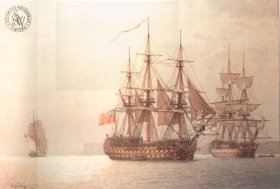HMS Glory (1788)
Appearance
 HMS Glory (center) in company with HMS Valiant
| |
| History | |
|---|---|
| Name | HMS Glory |
| Ordered | 16 July 1774 |
| Builder | Plymouth Dockyard |
| Laid down | 7 April 1775 |
| Launched | 5 July 1788 |
| Honours and awards |
|
| Fate | Broken up, 1825 |
| General characteristics [1] | |
| Class and type | Duke-class ship of the line |
| Tons burthen | 194417⁄94 bm |
| Length |
|
| Beam | 50 ft 1+3⁄8 in (15.3 m) |
| Depth of hold | 21 ft 2 in (6.45 m) |
| Propulsion | Sails |
| Sail plan | Full-rigged ship |
| Armament | |
HMS Glory was a 98-gun second-rate ship of the line of the Royal Navy, launched on 5 July 1788 at Plymouth.
History
[edit]In 1798, some of her crew were court-martialed for mutiny.[2]
Glory served as the flagship of Rear-Admiral Sir Charles Stirling at the Battle of Cape Finisterre in 1805, commanded by Captain Samuel Warren.
Glory was re-rated as a prison ship at Chatham on 27 September 1809. Lieutenant Richard Simmonds commanded her in 1810 and 1811.[1][Note 1] His replacement was Lieutenant Robert Tyte and Vice Admiral George Murray in 1794.[1]
Fate
[edit]Glory was paid off into ordinary in August 1814. In 1815 the navy used her as a powder hulk. She was ordered to be broken up in 1819; break up was completed at Chatham on 30 July 1825.[1]
Notes
[edit]- ^ In 1812 Simmonds assumed command of the gunbrig HMS Attack.[3]
Citations
[edit]- ^ a b c d Winfield (2008), p. 21.
- ^ MacDougall, Phillip (2022). "The Naval Mutinies of 1798". The Mariner's Mirror. 108 (4). Society for Nautical Research: 423–428.
- ^ Winfield (2008), p. 339.
References
[edit]- Lavery, Brian (2003) The Ship of the Line - Volume 1: The development of the battlefleet 1650-1850. Conway Maritime Press. ISBN 0-85177-252-8.
- Winfield, Rif (2008). British Warships in the Age of Sail 1793–1817: Design, Construction, Careers and Fates. Seaforth Publishing. ISBN 978-1-86176-246-7.
External links
[edit] Media related to HMS Glory (ship, 1788) at Wikimedia Commons
Media related to HMS Glory (ship, 1788) at Wikimedia Commons
